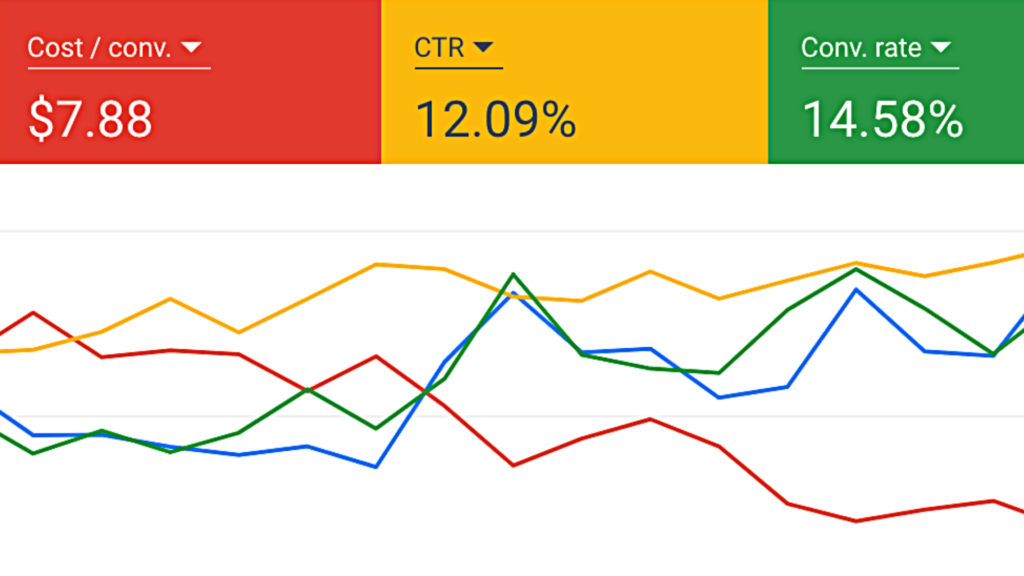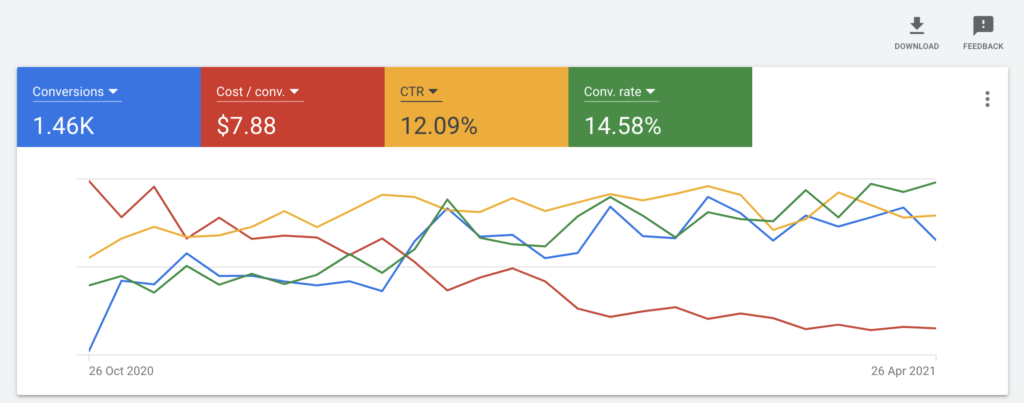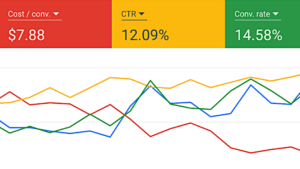Digital marketing is not magic. However, the sad truth is that most people create their Google Search Ads campaign half-assed, do absolutely nothing with it after it goes live, and expect magical results.
If the initial results of a campaign don’t look too promising, it is abruptly stopped and ad dollars are quickly moved to the next promising ad platform. If you’re using this “spray and pray” approach to Google Search Ads, stop right now. Every “failed” campaign in your account could have been fixed, improved, and fine-tuned over time to become a powerful growth engine for your business.
The key to successful campaigns is to continuously optimize and improve the key metrics that make up the campaign. Here’s an example of a campaign that I helped manage:
In a span of six months, the campaign’s performance improved in almost every key metric that mattered for the client:
- Conversions – The more conversions you get, the better. However, quality also matters, especially if you’re focused on lead generation.
- Cost/Conversion – The lower your cost per conversion, the higher your return in terms of revenue and ROI, and the more conversions you can achieve without increasing your budget.
- CTR – The Clickthrough Rate measures the effectiveness of your ad in getting clicks. The higher your CTR, the less you’ll pay per click (in Google Ads) and the higher your number of clicks.
- Conversion Rate – This metric reveals how effectively you convert visitors from your ads into sales and leads. Again, the higher your conversion rate, the better your return will be.
This campaign started weak or average at best. It was getting the client a lot of leads but at a very high cost. However, by the end of the six-month timeframe, it helped the client increase overall revenue by 34% during a difficult phase of COVID-induced lockdowns and economic uncertainty.
The Key to Optimizing Google Search Ads
In my Digital Marketing Domination course, I go into great depth about understanding your market, developing customer avatars, and creating a marketing strategy that addresses your entire marketing funnel. I highly recommend that you get that course if you’re frustrated with digital marketing.
So let’s assume for a moment that you know your market and that you have a solid marketing strategy in place. The only problem you’re having right now is a poor digital campaign.
Here’s how you can start.
- Track everything – Implement Google Tag Manager and Google Analytics. Make sure that your conversion tracking and landing pages have been set up properly. Track your leads, sales, and just about everything else that matters to your business. You’ll want to know the overall impact of your digital marketing campaigns.
- Have a data-first mindset – Most people rely on opinions, hunches, hearsay, and “best practices” when they create a digital marketing campaign. You need to stop doing this and rely on the numbers. As I emphasize in my “5 Biggest Mistakes in Digital Marketing” video, the only thing that matters is user behavior, which is measureable and actionable.
So with those few things taken care of, let’s talk about these four metrics and what you can do to improve them.
You’ll notice that I add the caveat “all else being equal” many times below because these metrics have a correlation and causation factor. When you tweak things to impact one metric, it also impacts the other three to some degree.
However, for the sake of simplicity, we’ll have to analyze each factor by itself.
Increase Your Conversions
This one is pretty simple. The more conversions you can squeeze out of a campaign, the better you’ll sleep at night. All else being equal, there are two ways to increase your conversions:
- Spend more money – Increasing your budget will almost always increase your conversions, if your other metrics are solid. However, more money will not fix a broken campaign, so be careful about spending too much at the start. Your initial budget should be high enough to get you impressions and clicks throughout the day.
- Improve the other three metrics – Conversions are a result of a well-executed campaign. You’ll see conversion improve naturally as you tweak your ads and landing pages.
Reduce Your Cost / Conversion
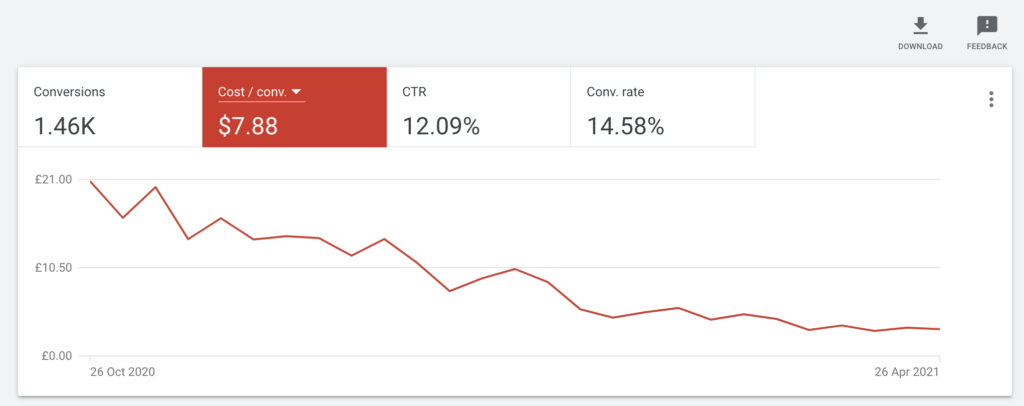
As you can see in the example, the cost/conversion reduced steadily over a period of six months. As you drive the cost lower, your campaigns become more profitable. All else being equal, here’s how to reduce your cost/conversion:
- Pause expensive keywords – Some keywords, although they may convert, suck up too much of your budget. If the cost/conversion is high relative to other converting keywords in your campaign, you may want to pause them and allow your budget to roll over to those keywords instead.
- Reduce your bids – Alternatively, you may want to keep converting keywords but reduce your bid amount. Be careful not to reduce too much at a time; a 10-20% reduction may lower your cost/conversion for a particular keyword without affecting other metrics like impressions or ad position.
- Add new keywords – Don’t settle for the keywords you started your campaign with. As you understand more about your target audience, you may discover new keywords, or keyword combinations, that cost much less and convert very well.
- Stricter keyword matching – Use phrase match whenever possible or exact match for specific keywords that may mean something completely different if the words appear in a different order.
- Negative keywords – Having a list of negative keywords is key to eliminating unwanted clicks. For this campaign, I added over 120 negative keywords over time. The less you spend on bad clicks, the lower your cost/conversion gets.
All the tweaks I recommend above need to be taken with a pinch of salt. Instead of applying them blindly, make small changes every week and observe their effect on your campaign after 14 days. Was the impact positive? Did it drive down your cost/conversion?
If it didn’t, you could always undo the action. The key here is to test one thing at a time, observe the results, analyze the data, and document your learning.
Increase Your CTR
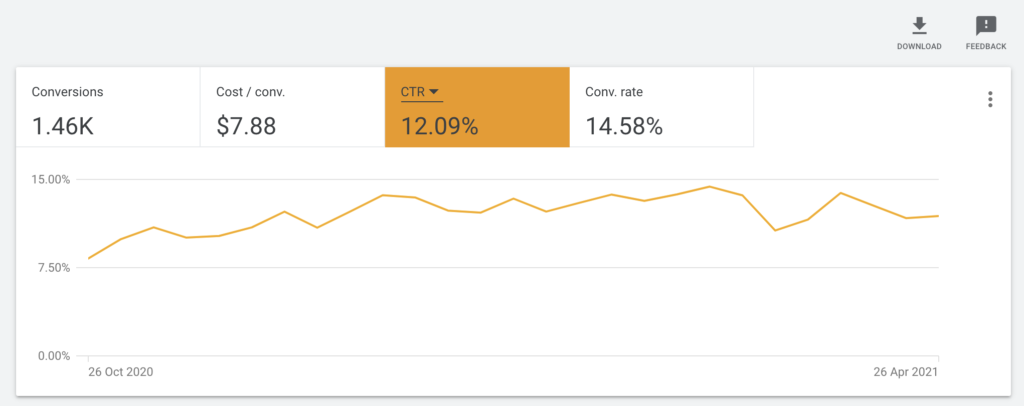
The CTR or Clickthrough Rate is almost always about your ad. The more you tweak and improve your ad, the higher your CTR gets over time.
Here are a few optimization tips that I use for ads:
- Create ad groups based on keyword themes – Everyone has their favorite way of organizing keywords. I found that creating keyword themes by grouping similar keywords helps you understand what your ad copy should say. Then, you can write better ads that resonate and are more likely to get clicked on.
- Have at least three ads running – To optimize Google Search ads continuously, you will need a few ads to split test. Keep the winning ad, and swap the losers with new ads. Over time, you’ll see the CTR increase.
- Dynamic keyword insertion – You can replace a part of the title with a dynamic keyword, which repeats the user’s exact search term in the title. Keyword insertion works best when you have a keyword + location combination term, for example, “digital marketing PJ.” It will be impossible to customize the ad to match the searched location manually, so I use keyword insertion instead to make the ad as relevant as possible.
Increase Your Conversion Rate

All else being equal, the biggest impact on your conversion rate is your landing page. Personally, I feel that optimizing your landing pages can yield much better results than tweaking ads or keywords. So how do you improve your landing pages?
- Don’t rely on a single landing page – If you’re bidding on keywords that range from top to bottom of the funnel, yet your landing page only speaks to people at the bottom of the funnel, your conversion rates are naturally going to be on the low side. Create one landing page per stage of the funnel, with copywriting and assets that match.
- Split-test critical components of the page – Marketers love A/B testing, but many start testing minor stuff (like the color of the button) first. The most significant impact on the landing page’s conversion rate comes from the headline, pain points addressed, and the gated asset (PDF/video). Test different assets and headlines first, and you’ll find considerable jumps in your conversion rate.
- Re-group keywords to match your landing pages – Reorganize your keywords according to the funnel stage (top, mid, and bottom-funnel) and use the landing page/asset that matches. For example, if the intent of the keyword indicates that the visitor is just researching information, use a landing page that offers gated information instead of pushing for a sale.
Still Not Getting Results?
Unfortunately, just implementing these tips rarely makes a difference in your account if you have the fundamentals wrong. What am I referring to?
I find that a lot of marketers create Google Ad campaigns without first figuring out these:
- The Ideal Customer Profile / Customer Avatar – Who is your ideal customer, and how can you reach and relate to them with your message?
- The user journey – What events or things need to happen before your ideal customer is ready to buy from you?
- The marketing funnel – How does Google Ads fit into your overall marketing strategy? How else can you reach the visitors who converted, and what can you do about those who did not?
- The sales funnel – How do you plan to recoup your ad costs, and how much revenue can you get from a single customer?
I created my Digital Marketing Domination course to address this gap. Through this course, you’ll learn how to create a solid, proven marketing roadmap for your product or service. You’ll discover a time-tested methodology to create a strategy that can help you achieve growth with a very small budget.

